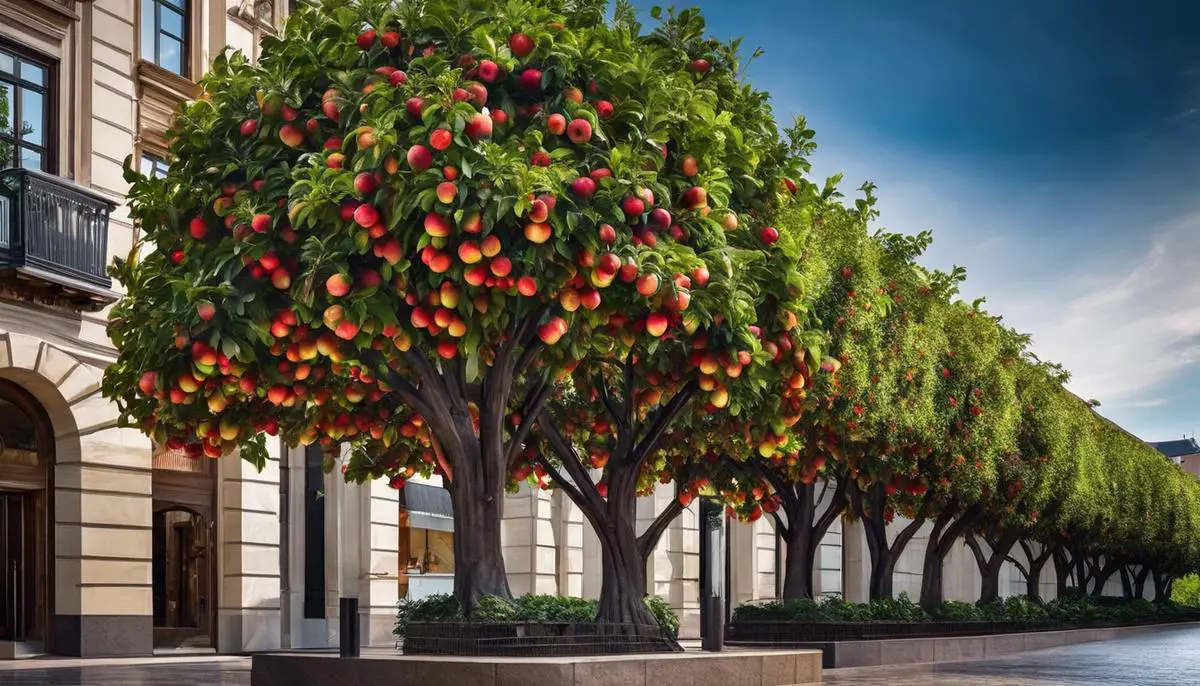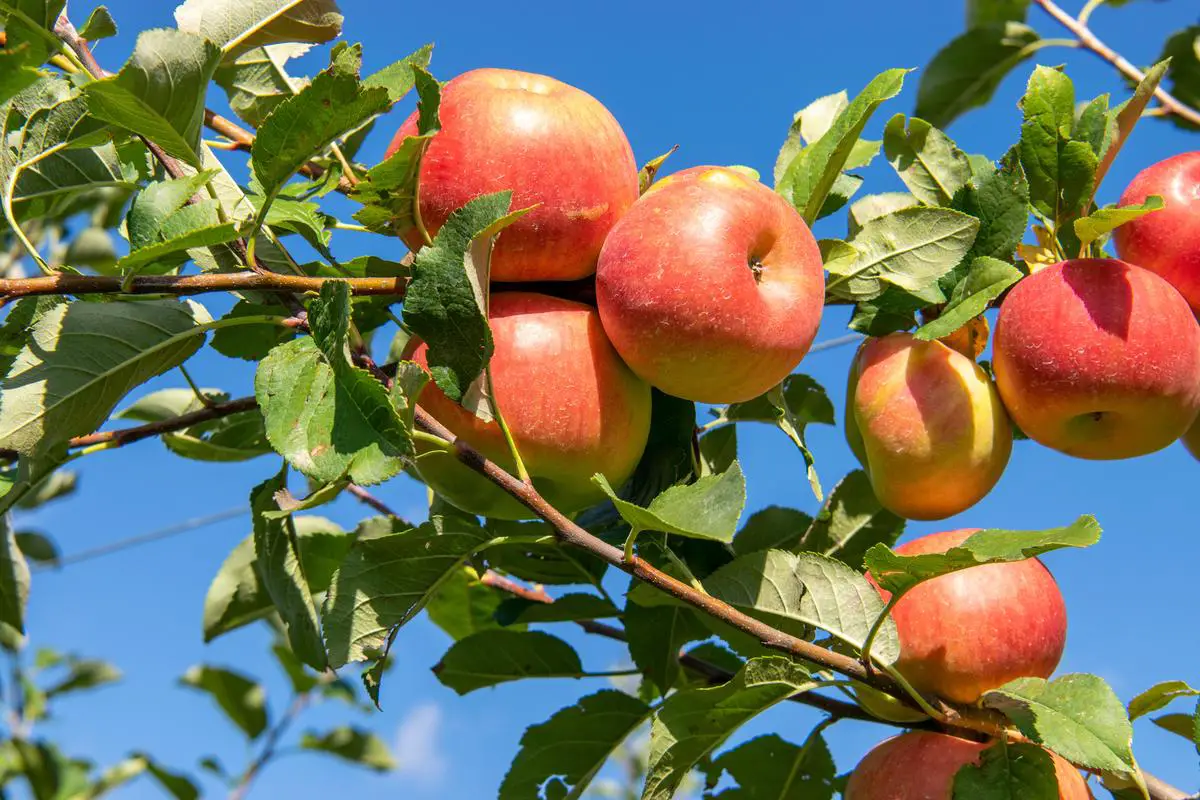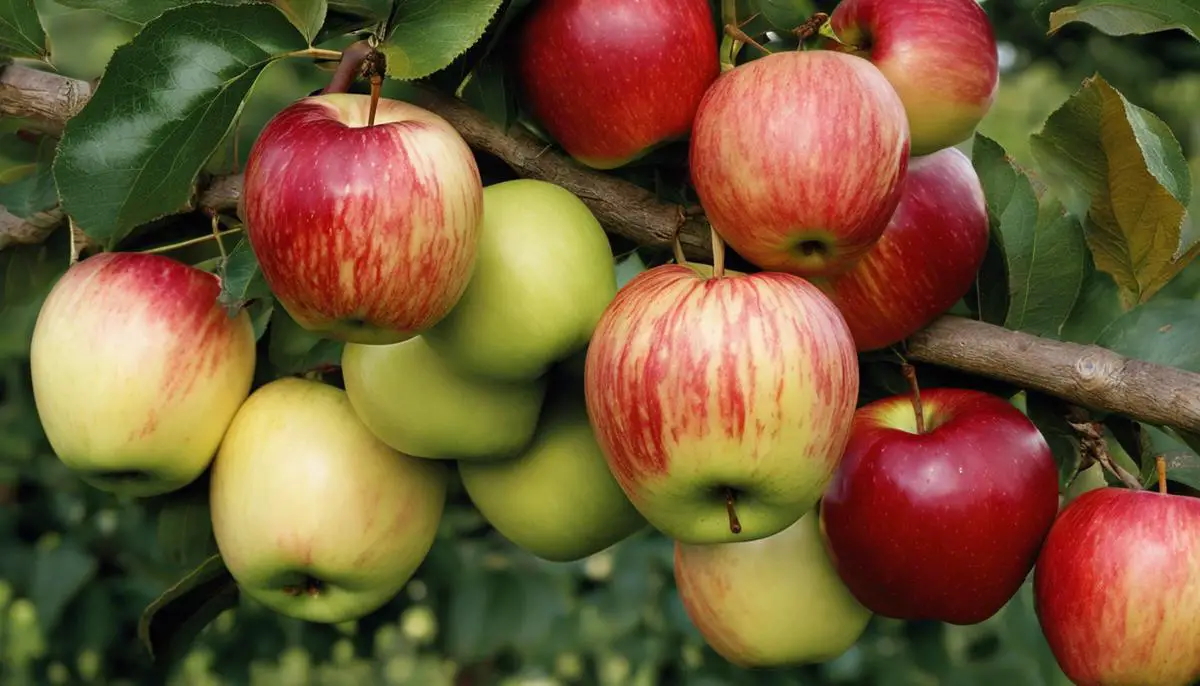Just when you thought apple trees couldn’t possibly offer anything more, enter the colonnade apple tree, a variety that boasts a unique appeal and charm. The colonnade apple tree is an appealing mix of extraordinary attributes – from the growth habit to the generous yield of fruits. They adorn many landscapes with their lovely aesthetics while simultaneously providing fresh and flavorful apples. In this quest to unravel the mysteries of the colonnade apple tree, let’s venture into the tree’s fascinating history, distinct differences from other apple trees, and the typical fruit yield. Packed with detailed gardening instructions, you will learn about planting, growing conditions, maintenance, and harvesting that come along with raising this remarkable tree.
Basic Understanding of Colonnade Apple Trees
The Unique Features of the Colonnade Apple Tree
Learning about apple trees might feel like a familiar story, but there’s one apple tree variant that may alter everything you think you know: The Colonnade Apple Tree. It has several characteristics that make it dramatically different from classic apple trees, turning traditional apple-growing wisdom on its head.
The Colonnade Apple Tree, sometimes known as the “Pillar” or “Urban” apple tree, truly stands out with its tight, vertical growth shape. This clearly contrasted to the typical wide-spread, bushy aspect of most apple trees. The vertical design does more than just offer an aesthetically pleasing alternative. It also makes it an ideal apple tree choice for compact or urban spaces, hence its other names.
Possessing narrow branches that ascend upward rather than out, these trees take up less horizontal space, leaving room for other plants, trees, or crucial backyard elements. Additionally, the Colonnade Apple Tree’s shape makes routine care, like pruning or harvesting, a lot simpler. There’s no need to climb ladders or reach into thick foliage. The fruits of this tree are easily accessible from the ground!
The fruits of the Colonnade Apple Tree are another highlight of this variety. Coming in different colors depending on the specific breed – from the golden ‘Goldrush’ to the red ‘Northpole’ – the apples themselves are usually quite sweet and flavorful. Plus, despite the trees’ slender shape, they are surprisingly fruitful. Given proper care, these trees can bear dozens of apples in a season.
Another notable feature of the Colonnade Apple Tree is its hardy nature. It can tolerate a wider variety of soils and climates than many other apple trees. Meaning it can be successfully grown in a broader range of locations. This combination of space-saving design, fruitful yield, and adaptability makes the Colonnade a remarkable choice for both novice and experienced gardeners alike.
In essence, the Colonnade Apple Tree represents a unique blend of characteristics. Its striking vertical growth pattern coupled with its resilience and abundant yield makes it a fascinating variant in the world of apple trees. Whether limited by space, or simply intrigued by its unusual attributes, it is well worth considering the Colonnade Apple Tree for your next apple-growing venture. It might just redefine what you think about apple trees.

Planting and Growing the Colonnade Apple Tree
Embracing the allure of these distinctive vertically shaped trees, let’s dive into the nuts and bolts of planting and nurturing a successful colonnade apple tree.
Nothing beats the satisfaction that comes from basking under the shade of a tree you’ve watched grow from seed to proverbial sky-scraping structure. By following these carefully researched steps, your sapling will metamorphose into a full-grown, fruit-bearing marvel in no time.
Choose the Right Spot
A colonnade apple tree flourishes in an area which receives full sun, especially in the morning, to dry off the morning dew quickly and prevent mildew. Ensure that the chosen area affords the tree enough room for its roots to spread out. Remember, roots can extend quite a distance from the trunk, so provide ample space to avoid future complications.
Soil Requirements
This remarkable tree isn’t finicky when it comes to soil, but it tends to thrive best in neutral to slightly acidic soil. Ensure the soil drains well to avoid waterlogging. If you’re working with heavy clay soil, you might want to consider amending it with well-rotted organic matter to improve the porosity.
Planting Process
After purchasing a healthy and robust colonnade apple tree from your local nursery, gently remove it from the container without causing trauma to the root system. Next, dig a hole about two to three times wider than the root ball and deep enough to keep the transplant at the same depth it was in its initial pot. Place the tree in the hole, backfill with soil, and firm it down gently to prevent air pockets from forming.
Provide Proper Care
Establishing an ideal watering routine for your colonnade apple tree is paramount. Newly planted trees require regular watering to keep the soil from drying out. However, maintain a fine balance to avoid over-watering. Infrequent deep watering is generally better than frequent shallow watering once the tree is established. In terms of fertilizing, an all-purpose garden fertilizer applied in early spring often proves beneficial to the tree’s health.
Protect the Tree
Tree guards, particularly during winter months, can offer protection against rodents. Also, a protective net thrown over the tree’s canopy during fruiting season ensures you get to savor the fruits of your hard work rather than the local bird population!
Pests & Disease Management
While the colonnade apple tree is relatively resistant to diseases and pests, it’s prudent to keep an eye out for sings of trouble. Common pests for apple trees include codling moth, aphids, and apple maggots, while common diseases involve mildew and apple scab. Regular checks, coupled with appropriate action, will keep these issues at bay.
Pruning Made Easy
Pruning ensures an abundant harvest and keeps the tree healthy. Aim for a once-a-year prune in late winter or early spring, cutting back the previous year’s growth by about one third. Remember to always remove diseased, damaged, or crossing branches to keep the tree’s open form.
A colonnade apple tree is an exciting addition to any gardening space. By following these pointers, this vertical wonder will not only bear delicious fruits in seasons to come but also stand as an enchanting testament to your green thumb. It’s time to ‘branch out’ and delve into the beauty of colonnade apple trees. Your garden will thank you for it.

Maintenance and Care of the Colonnade Apple Tree
The strategic placement for a Colonnade Apple Tree extends beyond convenient pruning or harvesting, it’s crucial to the tree’s health and fruit productivity. Aim to settle your Colonnade Apple Tree in the sunniest spot possible. We recommend at least 6 hours of direct sunlight daily. This ensures profuse blossoming and optimal apple production.
In the realm of soil requirements, well-drained soil is crucial for the growth and health of your Colonnade Apple Tree. Roughly a pH level from 6.0-7.0 suits it best. If your soil is clayey, consider investing in organic matter like compost or aged manure to nurture its development. This not only improves the soil structure but also aids in moisture retention, an essential aspect of tree care that we’ll discuss further below.
Planting your Colonnade Apple Tree appropriately is pivotal to building a firm foundation. Dig the hole twice as wide but only as deep as your tree’s root ball. Position your tree, with the topmost root level with the ground then backfill it with your soil-compost mix. Firm up the soil to eliminate air pockets, but avoid over-tightening which could stifle healthy root growth.
Meeting the watering needs of your Colonnade Apple Tree is fundamental to its health and vitality. While its water requirements may be average, do note that it fares less well in overly swampy conditions. During watering, focus on deep soaking instead of shallow sprinkling. This encourages downwards root growth. After the first watering, a suitable routine may be to water the tree weekly, or more frequently during dry spells.
Fertilizer application enhances the overall performance and yield of a Colonnade Apple Tree. An application in early spring, before the growth starts will allow the tree to absorb nutrients for the burgeoning season ahead. Use a balanced slow release fertilizer to encourage overall tree health and bountiful harvests.
Trees, especially fruiting ones, can be easy targets for wildlife. A tree guard at young stages of growth can ward off munching rodents. As for birds, they are great for insect control, but may also relish in your ripening fruits. An easy solution would be to use reflective bird diverters or netting to keep your harvest intact.
Pest and disease management is vital in ensuring your Colonnade Apple Tree thrives. Regular inspection of your tree is the starting point in identifying any potential issues early. Fungal diseases can be kept at bay with a dry environment, proper air circulation, and preventative fungicidal sprays. As for insects, handpicking or horticultural oils can be effective in managing these critters.
Pruning takes a front seat in maintaining the health or aesthetics of Colonnade Apple Trees. It’s an annual affair performed in late winter or early spring. Pruning involves removing dead, diseased or crossing limbs to allow plenty of sunlight and air into the tree. The goal is to maintain the spine-like vertical growth. Start by trimming about a third of the previous year’s growth.
Through timely care and maintenance, the cultivation of Colonnade Apple Trees can develop from an interesting novelty into a fruitful and enjoyable hobby where you literally reap the fruits of your labor. Happy Gardening!

Photo by sparkledump on Unsplash
Harvesting and Utilization of Colonnade Apples
The perfect time to harvest colonnade apples is when they’ve reached their full size and have taken on a vibrant, rich color. They should feel firm but not hard and the stem should come away from the tree easily when the apple is twisted slightly. The exact color of the apple depends on the variety – yours could be anything from red to yellow or even green. An important thing to remember is that apples ripen from the outside of the tree first, so start there and work your way inward.
Keep in mind that cooler temperatures slow down the ripening process, so if you’ve got a late season variety it might take longer for them to be ready. On the flip-side, if you’re dealing with a very warm season, they could be ready earlier than you expect. So it’s great to keep a close eye on your tree as the seasons change.
When it comes to harvesting your colonnade apples, a steady hand is required. Gently twist and pull each apple, ensuring that you don’t damage the spur (the small bit of wood the apple grows from). Damaging the spurs could reduce the amount of fruit your tree produces next year. Also don’t forget, fallen apples should be picked up as soon as possible to avoid attracting pests.
Alright, so you’ve harvested your beautiful bunch of colonnade apples. But what should you do with them? Because of their variety of colors and flavors, colonnade apples offer distinct and versatile usages. Some are perfect for applesauce, pies, and other baked goods because of their sweet-tart flavor and soft texture when cooked. Others have the firm crispness that makes them perfect for fresh eating or adding crunch to salads. If you’re really ambitious, you can try turning the juice into apple wine, cider, or vinegar.
In general, most apples, including the colonnade variety, need to be stored in a cool place – a root cellar, refrigerator, or cold garage – to extend their shelf life and keep them tasting fresh. For longer-term storage, they can be canned, frozen, or dried. It’s up to you to try and test the different ways you can savor these apples long after harvest season has passed!
In the end, growing and harvesting colonnade apples, not to mention the multitude of delights they can be used in, is a joy to behold. These skinny marvels offer such a wealth of flavors and uses, it’s no wonder they are returning to favor in gardens all over the country.

With a rich understanding of the colonnade apple tree’s intriguing characteristics, maintenance needs, planting and harvesting procedures, we reveal a world of opportunities. Whether you look forward to serving your freshly baked apple pies, relish the joy of home-brewed apple cider, or simply love biting into a fresh, crisp apple straight from the tree – colonnade apple trees stand as a testament to nature’s generosity. Provided with the appropriate care, these trees can transform any garden into a beautiful orchard and the simple act of gardening into an incredibly satisfying experience. Therein lies the magic and charm of the colonnade apple tree.